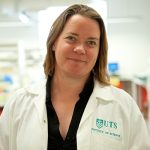Nerve fibres in the brain and spinal cord are insulated with a protein called myelin. The myelin sheath allows information to be rapidly passed along the nerve fibres to its intended destination. Specialised cells called oligodendrocytes make myelin, and form new myelin after it is damaged or lost in a process called remyelination. In MS, oligodendrocytes are lost or damaged and the process of forming myelin is compromised. The reason that remyelination fails in MS is not known, but remyelination failure is a key reason for the progression of disability and symptoms.
Dr Cullen will determine whether remyelination is due to changes in communication between neurons and the immature cells that become myelin producing cells. Importantly, this research will trial a safe non-invasive therapy, called repetitive transcranial magnetic stimulation, designed to manipulate and correct this communication block between nerves and oligodendrocytes to enhance remyelination and improve the symptoms of MS.
The first phase of Dr Cullen’s study showed that repetitive transcranial magnetic stimulation was able to stimulate the generation of new myelin producing cells in the healthy brain. She also used this time to optimise the magnetic stimulation processes and patterns to achieve the best results. Using her optimised process, Dr Cullen was able to double the number of new myelin producing cells in specific areas of the brain. Unexpectedly, these results may suggest that the transcranial magnetic stimulation may work by enhancing the survival of myelin producing cells to result in their increased numbers. This has led to new theories about the survival of myelin producing cells in the healthy brain which may have important implications for myelin repair therapies in MS. Importantly, Dr Cullen also showed that the transcranial magnetic stimulation did not alter the structure of the pre-existing myelin producing cells, indicating that it does not cause harm to the cells.
The second phase of the research concentrated on whether these results would hold true in models of myelin damage or MS-like disease in mice. In the first laboratory model, myelin damage is represented as a single discrete lesion. Using this model has allowed Dr Cullen to be very specific in her application of the transcranial magnetic stimulation and to show new myelin producing cells do appear within the lesion site under the microscope. Dr Cullen is currently writing these important results up for publication in a scientific journal.
She is also continuing her work to analyse the amount and quality of the new myelin being laid down in the lesion site. This is important to understand as it will indicate whether the treatment has the potential to restore a healthy quantity and quality of myelin to make a difference to the function of the nerves. She is also examining the effects of the transcranial magnetic stimulation on the inflammatory model of MS-like disease that more fully represents the situation seen in human MS.
The success of these experiments have laid the foundation for Dr Cullen’s colleagues to start moving forward into clinical trials to test the use of transcranial magnetic stimulation in people with MS as a therapy to repair existing damage in progressive MS.
Her exciting findings have been presented at several national and international meetings and have led to a number of academic publications. This fellowship has enabled Dr Cullen to contribute to training the next generation of MS research by co-supervising PhD students, junior post-doctoral scientists and research assistants. Dr Cullen and her supervisor Dr Kaylene Young have also subsequently been awarded an MS Research Australia project grant to begin several Australian collaborations as well as an international collaborations with a group in Paris.
Updated: 31 March 2019
Dr Carlie Cullen
$207,000
2016
3 years
Past project

